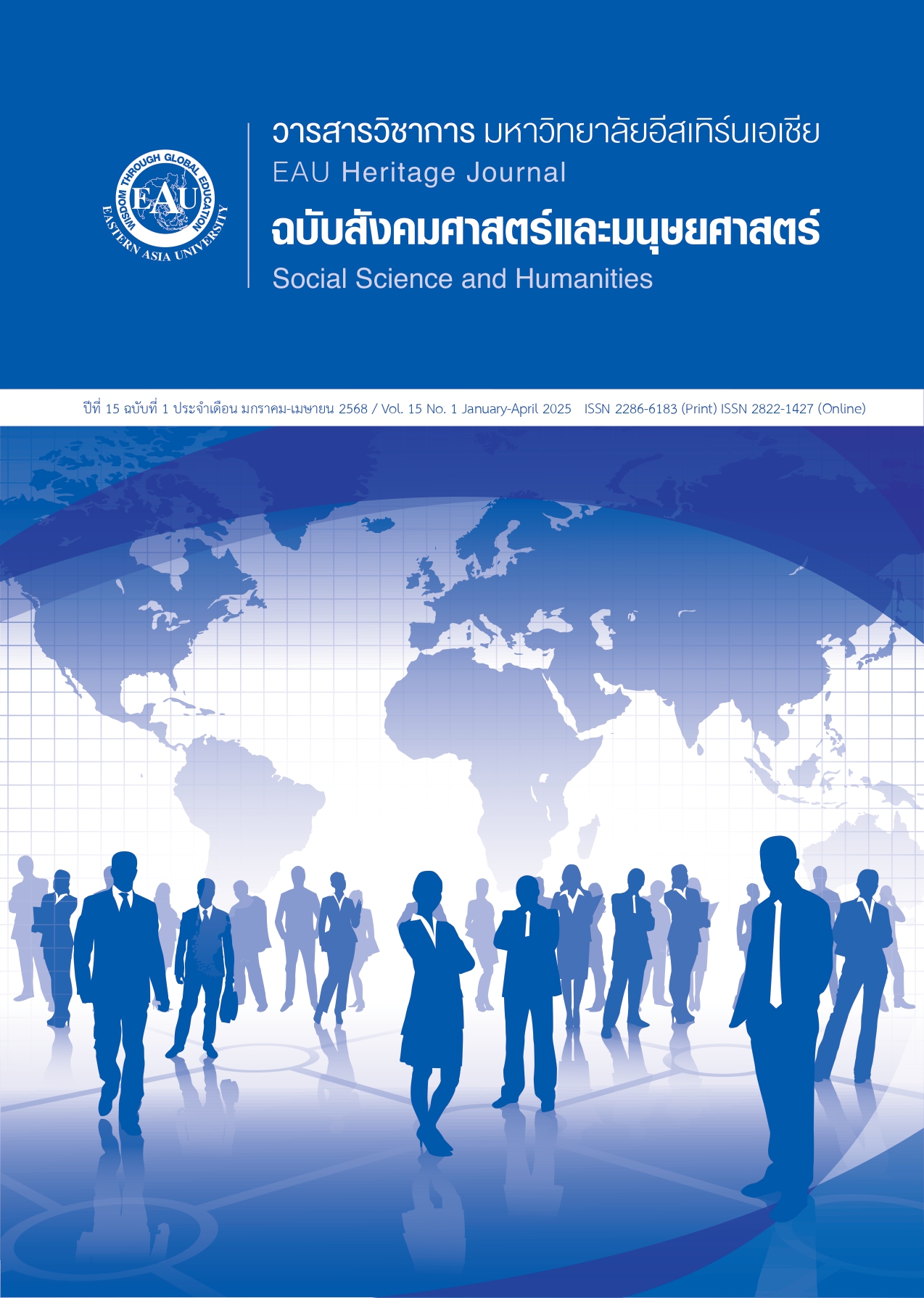แนวโน้มความปลอดภัยการบินในอนาคต: ผลกระทบจากการเปลี่ยนแปลง ในศตวรรษที่ 21
คำสำคัญ:
ความปลอดภัยการบิน, การเปลี่ยนแปลงในศตวรรษที่ 21, เทคโนโลยีการบิน, การพัฒนาที่ยั่งยืน, การเปลี่ยนแปลงสภาพภูมิอากาศบทคัดย่อ
บทความนี้นำเสนอแนวโน้มความปลอดภัยการบินในอนาคตที่ได้รับผลกระทบจากการเปลี่ยนแปลงในศตวรรษที่ 21 โดยวิเคราะห์การเปลี่ยนแปลงใน 4 ด้านหลัก ได้แก่ (1) ด้านวิทยาศาสตร์และเทคโนโลยี ซึ่งครอบคลุมการพัฒนาอุปกรณ์การบินและอวกาศ เทคโนโลยีคลาวด์ อากาศยานไร้คนขับ และอากาศยานขึ้นลงทางดิ่ง (2) ด้านเศรษฐกิจและสังคม ที่เน้นการพัฒนาที่ยั่งยืนตามเป้าหมายขององค์การสหประชาชาติ (3) ด้านการดำรงชีวิตและสภาพการทำงาน ที่สะท้อนถึงความกดดันและความเครียดที่เพิ่มขึ้นในอุตสาหกรรมการบิน และ (4) ด้านสิ่งแวดล้อม ที่เกี่ยวข้องกับผลกระทบจากภาวะโลกร้อนและการเปลี่ยนแปลงสภาพภูมิอากาศ บทความนี้ยังนำเสนอข้อเสนอแนะเชิงนโยบายและเชิงปฏิบัติสำหรับการรับมือกับการเปลี่ยนแปลงดังกล่าว
เอกสารอ้างอิง
Airlines for America. (2021). Air travelers benefit from robust industry competition. Retrieved from
https://www.airlines.org/air-travelers-benefit-from-robust-industry-competition/
Amornpipat, I. (2020). Stress of employees working in the aviation industry: A study of Bangkok
Airways Limited ground service agents. International journal of scientific and research
publications, 10(8), 441-445. Doi: https://doi.org/10.29322/JSRP.10.08.2020.p10454
Aviation Safety Network. (2023). Incident Boeing 777-200 JFK International Airport. Retrieved from
https://aviation-safety.net/database/record.php?id=20230113-0
Bureau d'Enquêtes et d'Analyses. (2016). Final report: Accident to the Airbus A320-211, registered
D-AIPX, operated by Germanwings. Retrieved from
https://www.bea.aero/uploads/tx_elydbrapports/BEA2015-0125.en-LR.pdf
Cheng, N., Shi, Z., & Wang, Y. (2022). Research on safety assessment method on integrated modular
avionics based on cascading effect analysis. Journal of physics: Conference series, 2228(1),
Doi: https://doi.org/10.1088/1742-6596/2228/1/012046
Civil Aviation Administration of China. (2024). Type certification granted for EH216-S. CAAC.
Cohen, J. (2006). Hurricane Katrina: Impact on aviation safety. Journal of environmental safety,
(4), 34-42.
Environmental Defense Fund. (2017). 5 ways climate change can make air travel worse. Retrieved
from https://www.edf.org/card/5-ways-climate-change-can-make-air-travel-worse
Eurocontrol. (2023). Understanding the impact of climate change on aviation. Retrieved from
https://www.eurocontrol.int/article/understanding-impact-climate-change-aviation
European Union Aviation Safety Agency. (2023). Certification update: Volocopter testing. EASA.
Farhud, D. D. (2015). Impact of lifestyle on health. Iranian journal of public health, 44(11),
-1444.
Federal Aviation Administration--FAA. (2023). Safety alert for operators: Fatigue risk management.
U.S.: Department of Transportation.
FAA. (2024). Certification progress report: Joby aviation. FAA.
Fila, G. V. (2021). Work-life balance for aircrews. Retrieved from
https://www.modul.ac.at/uploads/files/Theses/Master/Grad_2021/MSC_2021/1521021_Fila_Thesis.pdf
Flight Safety Foundation. (2023). Lifestyle and adverse performance effects. Retrieved from
https://skybrary.aero/articles/lifestyle-and-adverse-performance-effects-oghfa-bn
Genovese, D. (2022). Pilot fatigue remains high concern as carriers try to recapture
revenue. Retrieved from https://www.foxbusiness.com/lifestyle/pilot-fatigue-remains-high-concern-carriers-try-recapture-revenue
Haris, S. R. M. (2021). Noise and time pressure effects on situation awareness and aviation
maintenance tasks. Retrieved from https://commons.erau.edu/cgi/viewcontent.cgi?article=1658&context=edt
Hobbs, A. (2016). Remotely piloted aircraft systems. Retrieved from
https://ntrs.nasa.gov/api/citations/20160014467/downloads/20160014467.pdf
International Civil Aviation Organization--ICAO. (2018). Safety management manual. (4thed.).
Retrieved from https://www.skybrary.aero/bookshelf/books/5863.pdf
ICAO. (2023). ICAO and the United Nations Sustainable Development Goals. Retrieved from
https://www.icao.int/about-icao/aviation-development/pages/sdg.aspx
Keller, J., Mendonca, F. A. C., & Adjekum, D. K. (2022). Understanding factors underlying fatigue
among collegiate aviation pilots in the United States. Safety, 8(2),
doi: https://doi.org/10.3390/safety8020046
Konopliov, A. (2023). Shift work statistics & facts (2023). Retrieved from
https://redline.digital/shift-work-statistics/
Kumar, S., & Smith, M. (2023). Business pressures and aviation safety: Industry analysis. Journal of
Air transport management, 56(2), 145-159.
Lee, D., & Chen, K. (2023). Post-COVID aviation workforce challenges. International journal of
aviation management, 15(3), 278-292.
Lee, D., & McDermid, C. (2019). Asia's aviation industry is booming, so why isn't it
making money?. Retrieved from https://www.scmp.com/week-asia/economics /article/2184740/asias-aviation-industry-booming-so-why-isnt-it-making-money
Leong, T. (2021). Tropical storms and aviation safety: A study of Southeast Asia's weather patterns.
International journal of aviation, 23(1), 59-65.
Lilium, & EASA. (2023). Design organization approval certification report. Lilium.
Miller, B. (2014). Does competition among employees work as a motivator?.
Retrieved from https://hrdailyadvisor.blr.com/2014/12/12/does-competition-among-employees-work-as-a-motivator/
Mohsan, S. A. H., Othman, N. Q. H., Li, Y., Alsharif, M. H., & Khan, M. A. (2023). Unmanned aerial
vehicles (UAVs): Practical aspects, applications, open challenges, security issues, and future
trends. Intelligent service robotics, 10(1), 109-137. Doi: https://doi.org/10.1007/s11570-022-00452-4
National Transportation Safety Board. (2023). Investigation report: FedEx incident 2022. NTSB.
_______________________________. (2024). Preliminary report: Alaska Airlines flight 1282 Boeing
-9 MAX. NTSB.
Noonkong, P. (2014). Get to know cloud computing office of academic resources
and information technology. Retrieved from https://arit.rmutsv.ac.th/th/blogs/82
Nordic Road and Transport Research. (2022). Increased competition in aviation has
negative effects on pay and working conditions. Retrieved from https://nordicroads.com/increased-competition-in-aviation-has-negative-effects-on-pay-and-working-conditions/
O'Hagan, A. D., Issartel, J., Mc Ginley, E., & Warrington, G. (2020). A pilot fatigue management
strategy for extended flight duty periods in commercial aviation. Aerospace medicine and
human performance, 91(12), 937-943.
Price, A. (2022). When a competitive workplace culture turns toxic. Retrieved from
Reilly, A. (2021). The future of flight will be built on safety. Retrieved from
https://aerospacetechreview.com/the-future-of-flight-will-be-built-on-safety/
SKYbrary Aviation Safety. (2023). Fatigue risk in maintenance. Retrieved from
https://skybrary.aero/articles/fatigue-risk-maintenance
Smith, R., & Brown, D. (2019). Wildfires and aviation: A case study of the 2018 California fires.
Aviation safety review, 19(2), 48-56.
Steinhage, A., Cable, D., & Wardley, D. (2017). The pros and cons of competition among
employees. Retrieved from https://hbr.org/2017/03/the-pros-and-cons-of-competition-among-employees
Thompson, J., & Garcia, R. (2021). Adaptation to new aviation technologies: A human factors
perspective. Journal of aviation technology and engineering, 8(2), 156-170.
United Nations Sustainable Development. (2015). Sustainable development goals
launch in 2016. Retrieved from https://www.un.org/sustainabledevelopment/blog/2015/12/sustainable-development-goals-kick-off-with-start-of-new-year/
Wilson, D., Driller, M., Johnston, B., & Gill, N. (2022). The prevalence and distribution of health risk
factors in airline pilots: A cross-sectional comparison with the general population.
Australian and New Zealand journal of public health, 40(5), 572-580. Doi: https://doi.org/10.1111/1753-6405.13231
Wisk Aero, & FAA. (2023). Safety testing report: Generation 6 autonomous system. Wisk Aero.
Yang, L., & Hu, J. (2021). The influence of work pressure on airline personnel's work errors in the
internet age. In journal of physics: Conference series, 2021 international conference on
mechanical automation and computer engineering (MACE 2020), 1744(4), 042245, doi:





